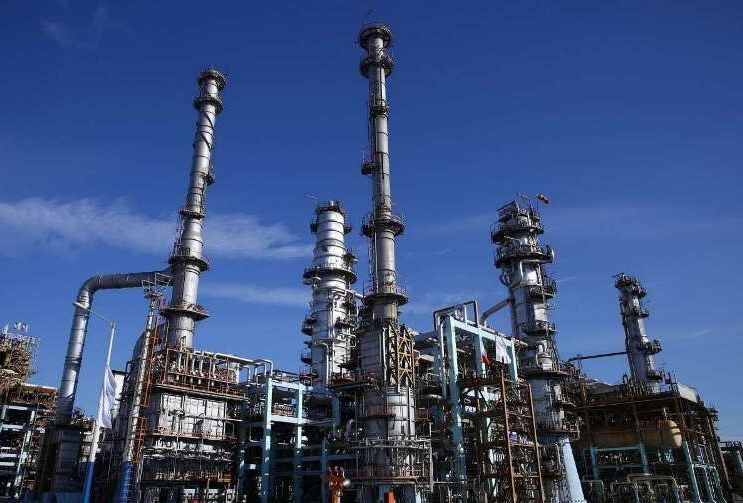In coincidence with the sharp decline in demand in the oil and petroleum products market, Iran reached unprecedented gasoil and gasoline production capacity last calendar year. Fuel imports were stopped and even Iran became an exporter of gasoline for the first time. As gasoline was rationed and its price increased, gasoline consumption level fell, preparing the ground for Iran to export gasoline amid US sanctions.
Chain of Development Activities
Iran’s Petroleum Ministry has organized a chain of development activities in order to increase the value-added of the petroleum industry, expand production capacity of petroleum products and improve their quality in addition to increasing petroleum products exports. Thanks to such measures, Iran’s refining capacity has increased from 1.8 mb/d in 2012 to 2.2 mb/d now, thereby raising Iran’s gasoline and gasoil production from 49.8 ml/d and 94 ml/d in 201 to 107 ml/d and 113 ml/d in 2019, respectively.
Due to measures undertaken to improve the quality of refined products, Euro-4 and Euro-5 grade gasoline production capacity rose from zero in 2012 to 76 ml/d in 2019.
Meantime, gas recovery from the giant offshore South Pars gas field has grown 2.5-fold and gas supply across Iran has expanded. Therefore, liquid products have been freed up to be exported. Petroleum products exports increased four-fold, going from 5.9 million tonnes in 2012 to about 23 million tonnes in 2019.
Future of Refining Industry
In a bid to set the stage for the development of oil refining industry, the Petroleum Ministry examined various options of future consumption of fuel in the country and summarized the results of mathematical calculations in the “Document on Energy Supply
to Transportation Sector in 2024 Horizon with Focus on Energy Efficiency”. The document has won the approval of High Council of Energy.
The document has set the minimum gasoline production capacity up to the 2024 Horizon, which should be achieved by upgrading the existing refineries and building new ones. The data has been communicated to National Iranian Oil Refining and Distribution Company (NIORDC). In this communication, the assumption is that long-term national needs for petroleum products be supplied while investment in creating excess refining capacities would be supported with a view to exporting a variety of petroleum products.
Gas Production Hits Record
The sweet and dreamy days of oil refining were not limited to gasoline exports instead of imports. Over the past two years, Iran’s 111-year-old petroleum industry has seen a win-win coexistence, leading to maximum production capacity from South Pars. Iran has outdone Qatar, with which it shares South Pars, in recovery from South Pars. Furthermore, Iran is extracting more than 700,000 b/d of condensate from South Pars. Increased gas production was good news for power plants, households, businesses, petrochemical plants, industries and export markets, but this record breaking also carried a big risk for Iran’s petroleum industry. What should be done with condensate which had been slapped with US sanctions?
As soon as the US imposed unlawful sanctions on Iran, some news agencies including Bloomberg and Reuters claimed that Iranian should brace for a decline in the South Pars output in winter. These projections never came true. Iran’s petroleum industry was based on an all-out coexistence. The gas condensate produced at South Pars was transferred to Bandar Abbas to feed a condensate refinery, there. The refinery made Iran independent of gasoline imports.
Golden Days
Last calendar year, gasoline consumption exceeded 100 ml/d on many occasions. However, strategic reserves never declined. Nor did gas stations faced any shortages. South Pars ran at full capacity. Meantime, the Persian Gulf Star refinery was a good consumer of condensate. The golden days of coexistence between South Pars and the Persian Gulf Star refinery continued, but as soon as the coronavirus pandemic hit Iran and social distancing and shutdown were enforced, gasoline consumption dropped 20% to 70 ml/d.
Neighboring nations experienced similar reduction in consumption. Thanks to the coronavirus outbreak, they all became exporters of gasoline. China, India, South Korea, Tajikistan and Kazakhstan decided to export gasoline and gasoil. As land borders were closed, Iran’s gasoline exports to neighboring nations were faced with challenges much tougher than US sanctions.
Some analysts did not hesitate to claim that Iran would soon experience shutdown of its oil refineries – a dream which never came true.
Naphtha, the Winning Card
As the proverb goes, life takes shape in moments. This old proverb was proven to be true for Iran’s oil refining industry. Faced with the coronavirus crisis and the subsequent decline in demand for gasoline, Iran unveiled a new card to prevent the shutdown of refineries and avoid any mandatory drop in the South Pars gas field. Naphtha was the most important winning card for Iran’s petroleum industry under the tough conditions of sanctions and covid-19. The strategic refining industry has turned Iran into a leading producer and exporter of gas-based naphtha in the region, few examples of which are seen in the market. The use of naphtha in both refining and petrochemical industries has kept demand unchanged.
Thanks to increased naphtha production from the Persian Gulf Star refinery, the Bandar Imam, Tabriz and Shazand petrochemical plants keep running.
Despite a mandatory reduction in oil production, naphtha never left petrochemical plants unfed. It was naphtha that helped increase propylene and polypropylene production at petrochemical plants across Iran. Naphtha has overcome US sanctions and defeated the coronavirus. In describing the naphtha days of Iran’s oil refining industry due to US unlawful sanctions, too much remains unsaid. But the petroleum industry will not easily forget these golden days.
Mahnaz Mohammad-Qoli
Courtesy of Iran Petroleum


Your Comment